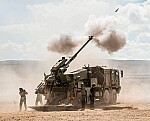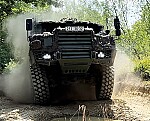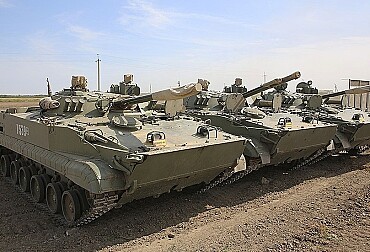Russia to relaunch production of the Soviet era T-80 tank – Ukraine intends to focus on BM Oplot
In recent years, much has been made of the T-14 Armata, the latest Russian tank, described as technologically far ahead of its Western counterparts. However, according to the official Tass agency, it has been used on several occasions in combat zones in Ukraine, and has clearly not given complete satisfaction, since it will once again have to undergo adjustments based on feedback from experience. However, no examples have been reported destroyed, damaged or captured. In addition to the T-14, and since 2019/20, Russian forces have also been fielding T-80BVMs and T-90M Proryv-3s, which are evolutions of tanks designed during the Soviet period.

Developed by Uralvagonzavod (UVZ) using technologies from the T-14 Armata, the T-90M is an evolution of the T-90A, which entered service with the Russian army in 1992. Weighing in at 50 tonnes, it is equipped with a new 1,130 hp powerplant, a 2A46M-4 125 mm smooth-bore cannon, a Kalina automated fire control system, a remotely operated 12.7 mm machine gun and Relikt active protection. In Ukraine, at least 37 examples have reportedly been disabled.
T-80BVM
The T-80BVM is an "upgraded" T-80BM, designed in the 1970s. This tank is equipped with a more powerful engine, a 1250 hp GTD-1250TF turboshaft better suited to the climatic conditions of the Far North, a 125 mm 2A46M-4 cannon with SOSNA-U day/night sight and automatic loader, as well as a Relikt active protection system.

As Red Samovar explains, the development of the T-80BVM may have come as a surprise, given that the T-80 did not enjoy good press within the Russian general staff, due to its excessive fuel consumption and disappointing performance. What's more, these "upgraded" tanks were intended primarily to equip units deployed in the Far North... However, they were also deployed in Ukraine... and 96 of them were reportedly taken out of action.
More generally, Russian forces have lost more than 600 T-80 tanks, all versions included. This means that at least 404 T-80BVs cannot be upgraded to the T-80BVM standard. However, Uralvagonzavod CEO Alexander Potapov made a surprising announcement on the Zvezda television channel on September 10. He stated that production of the T-80 tank would be relaunched, even though Uralvagonzavod had not produced a new tank of this type since the early 1990s. "This is the task the army has set us", he said. He explained that this decision was "influenced by the effectiveness of the T-80" in Ukraine. "And now we're actively working on this issue with the Ministry of Industry and Trade, because it requires new capabilities as a result," Potapov added.
Indeed, relaunching assembly lines that were shut down over thirty years ago is no mean feat, even if we can assume that Uralvagonzavod has retained the necessary equipment, and even then, it has to be in good condition. This means making major investments and finding suppliers and other subcontractors to get the logistics back on track. And it takes time: in 1993, a study by the US Congress estimated that it would take 56 months to restore full production capacity for M1 Abrams tanks from scratch.
BM Oplot
The BM Oplot is a Ukrainian battle tank. It was developed in 2000 by the KB Morozov design bureau and produced by the Malyshev factory in Kharkov. The BM Oplot is not in service with the Ukrainian army. The BM Oplot is an evolution of the Ukrainian T-84 battle tank, itself developed from the T-80UD tank. In 2009, the BM Oplot was approved for service by the Ukrainian Ministry of Defence. Due to a lack of funding, it has not been delivered to the armed forces.
The BM Oplot has a mechanically-welded turret with modular armour and Duplet reactive overarmour. The automatic loading system is installed in the turret well. The BM Oplot-M has a panoramic tank commander's sight and an improved fire control system. On 1 September 2011, Thailand ordered 49 examples of the BM Oplot-T tank and 2 BREM-84 Atlet recovery and evacuation vehicles for $240 million. Delivery was initially scheduled for 2014. Production has been significantly delayed. The first series of five tanks was handed over to the Thai army in November 2013, the second in May 2015, the third in May 2016, the fourth in November 2016 and the fifth in June 2017.
Concerning not only tank, Ukraine naturally intends to focus on its industry. Already back in spring 2023 the Ukrainian Ministry of Defence has announced that it will be ordering BM Oplot tanks produced by the Malyshev factory in Karkhiv, a subsidiary of Ukroboronprom. "I am convinced that a Ukrainian tank like the BM Oplot should be at the forefront of the tank coalition. I love the food and music of the different peoples of the world, but when it comes to industry, I'm still a protectionist. That's why it was decided to order BM Oplot from Ukroboronprom for army", Ukrainian Defence Minister Oleksiy Reznikov said on 12 May (On 3 September, President Volodymyr Zelenskyy has dismissed Reznikov as minister of defense).
How do the T-90M and T-84 Oplot-M battle tanks compare?
In terms of firepower/armament, fire control, protection (armour packs, active protection systems, etc.), they're comparable. It's important to remember what these tanks represent. They are the end of a long line of Soviet tank development. The Soviet Union and its Warsaw Pact produced many capable models – and now, the global contenders for that legacy would mostly be Russia, Ukraine, and Poland.
The biggest physical difference between the Russian T-90 and the Ukrainian T-84 is length – the T-90 being a considerably longer tank. The T-90 is a major redevelopment of the T-72, while the T-84 is a major redesign of the T-80. Had Russia and Ukraine continued to cooperate in tank development, they would probably have produced tanks that could outperform these and the Armata. Instead, their lack of cooperation has damaged tank development in both countries. Indeed, it is questionable whether they really have the industrial capacity to produce their best tanks in numbers.
It is important to note that Russia clearly has deeper industrial capabilities to compensate for the loss of cooperation with Ukraine. It continues to upgrade its entire fleet of T-72, T-80 and T-90 tanks, as well as preparing for series production of the advanced MBT, the T-14 Armata (while incorporating much of this tank's technology into its upgrades of older tanks). Ukraine continues to modernise its T-84.
Losses in the Ukraine War
According to the Oryxspioenkop.com, Ukraine has lost 702 tanks so far, of which 473 were destroyed. Among these we can find 57 T-80BVs, while Russia has lost 2552 tanks of which 1674 were destroyed. Among them we can see 3 T-80Bs, 460 T-80BVs, 97 T-80Us, 2 T-80UKs, 6 T-80UE-1s, 1 T-80UM2, 114 T-80BVMs, and 11 unindetified T-80s, and also over 90 T-90s of different versions.









